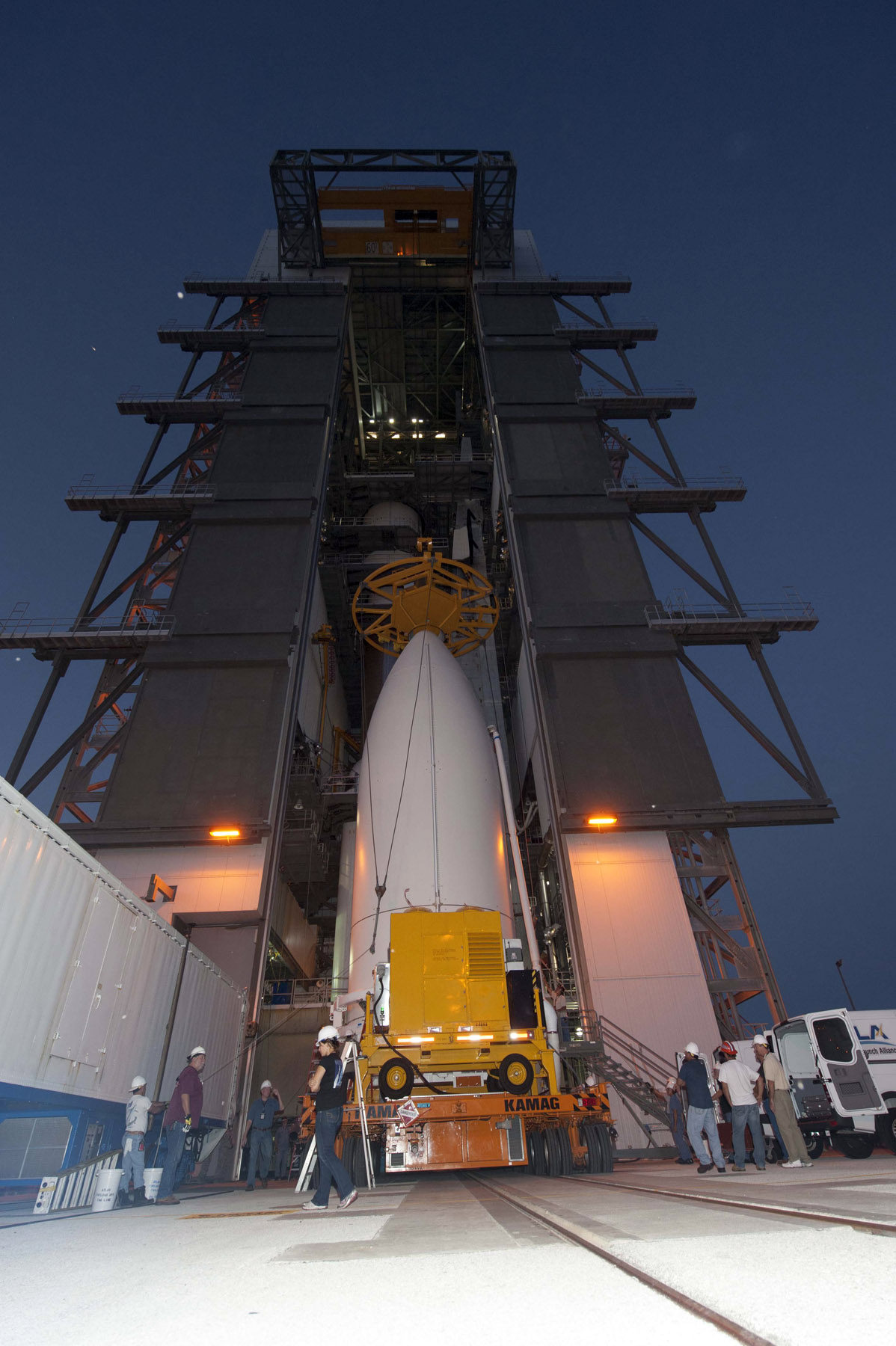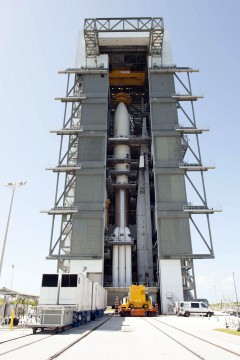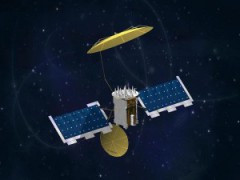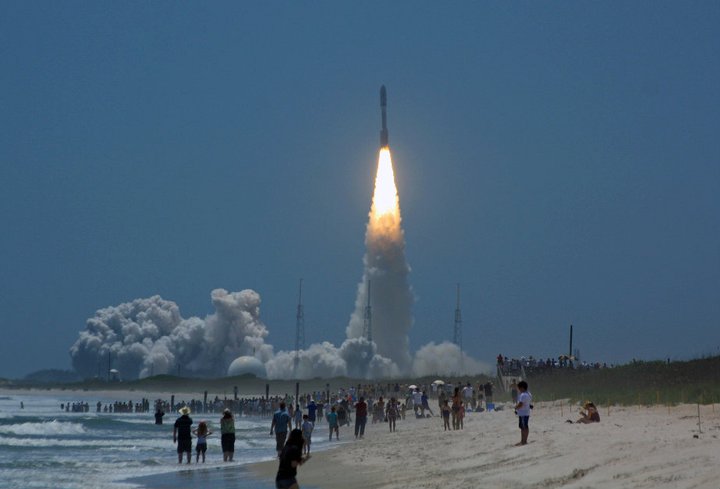
On Friday morning, United Launch Alliance (ULA) will stage the fourth flight of its Atlas V in the “heavyweight” 551 configuration to insert the U.S. Navy’s large Mobile User Objective System (MUOS)-2 satellite into geosynchronous orbit, more than 22,000 miles above Earth. The giant satellite represents part of the next generation of narrowband tactical satellites, offering U.S. forces improved communications capability while on the move. Liftoff of the Atlas—which features a 5.4-meter (17.7-foot) payload fairing, five strap-on solid-fueled rockets, and a single-engine Centaur upper stage—is currently scheduled to occur from the storied Space Launch Complex (SLC)-41 at Cape Canaveral Air Force Station, Fla., during a 44-minute “window” which extends from 8:48-9:32 a.m. EDT.
Stacking of the Atlas V 551 at the Cape got underway on 29 May in the Vertical Integration Facility, when the 106.6-foot-long Common Booster Core (CBC)—the central component of the vehicle’s first stage—was rotated into position on its mobile launch platform. Over the following few days, the five Aerojet-built solid rockets were affixed to their mounting points on the first stage, and on 11 June the 41.5-foot-long Centaur upper stage was hoisted atop the stack. Last Monday (8 July), the MUOS-2 satellite, encapsulated within its bullet-like payload fairing, was mounted atop the rocket for flight. In total, the Atlas V stands 206 feet tall.

This reliable vehicle—which has flown 38 times since August 2002 with near-perfect accuracy and mission success—will provide the combined impetus to boost MUOS-2 into a target geosynchronous orbit, joining its sister MUOS-1, which was launched last year. Three further satellites will be launched by 2015-16, under contracts awarded by the U.S. Navy to Lockheed Martin. When fully operational, the system will replace the current Ultra-High-Frequency Satellite Communications (UHF SATCOM) network, providing users with ten times more communications capacity over existing systems.
The MUOS satellite seeks to offer global satellite communications narrowband (64 kbits/sec and lower) connectivity for use by U.S. and allied forces, with an ultra-high frequency range from 300 MHz-3 GHz. When fully functional, it will replace the legacy UHF Follow-On (UFO) satellite network—the first of which was launched back in March 1993—before the latter system reaches its end of operational service. MUOS will provide new capabilities and enhanced mobility, access, capacity, and quality of service, with particular emphasis upon mobile users, such as aerial and maritime platforms, ground vehicles, and dismounted soldiers. It will extend their voice, data, and video communications lines far beyond their physical lines of sight.
By operating in the UHF frequency band, which is lower than that used by conventional cellular networks, MUOS will provide U.S. and allied warfighters with the tactical ability to communicate in “disadvantaged” environments, including heavily forested areas where higher-frequency signals would be otherwise impaired. Even troops in buildings with no satellite access are expected to see an increase in communications capability. The original contract between Lockheed Martin and the U.S. Navy’s Communications Satellite Program Office was announced in September 2004, extending for seven years and valued at $2.1 billion, for an opening two-satellite Initial Operational Capability. That contract has since been extended and present schedules envisage the launches of MUOS-3 and MUOS-4 next year, followed by MUOS-5 in 2016. All will utilize the Atlas V 551.

Lockheed Martin completed required systems testing on MUOS-2 in January 2013, following what was described as “an efficient integration and test campaign” by Iris Bombelyn, vice president for the company’s Narrowband Communications Mission Area. The satellite was then placed into storage, and in May 2013 it was delivered to Cape Canaveral Air Force Station for final testing, propulsion system fueling, and payload fairing encapsulation. “MUOS-2 will add on-orbit military satellite communication that is heavily in demand,” explained Bombelyn. “Our first space vehicle has performed exceptionally on-orbit, providing legacy payload voice calls at full capacity. In fact, we recently demonstrated mobile data and voice transmissions using our advanced payload.”
The presence of four MUOS-dedicated ground stations around the world has triggered recent and ongoing controversy in Sicily, where equipment is based at the Naval Radio Transmitter Facility Niscemi, about 40 miles from the U.S. Navy’s Naval Air Station Sigonella. Local residents have demonstrated in opposition to perceived health risks of long-term exposure to electromagnetic radiation from the Niscemi installation. This opposition, coupled with several high-profile reports which have highlighted the associated health dangers, led to an impasse which halted work on the MUOS site. An Italian appeals court ruling and the results from a pair of health studies are expected in the near future, and the United States hopes that this will break an impasse which has already generated considerable anti-American sentiment.
Original plans called for the first MUOS satellite to be launched by 2010, but budgetary adjustments made in response to the Iraq war led to a two-year delay. The first mission was launched on 24 February 2012. Friday’s scheduled mission represents only the fourth occasion in the Atlas V’s 11-year, 38-flight history to utilize the 551 configuration: MUOS-1 used it, as did NASA’s New Horizons spacecraft, bound for Pluto, which was launched in January 2006, and the Juno orbiter, despatched toward Jupiter in August 2011.

The MUOS-2 launch will get underway at T-2.7 seconds with the ignition of the Atlas V’s Russian-built RD-180 first-stage engine, with a propulsive yield of 860,000 pounds. This powerplant burns liquid oxygen and a highly refined form of rocket-grade kerosene, known as “RP-1.” The five Aerojet-built solid rockets, each measuring 67 feet tall, will also ignite and produce a total thrust of 1.9 million pounds to supplement the initial boost. Climb-out of the vehicle from SLC-41 will commence at T+1.1 seconds, beginning an apparently slow climb to about 85 feet by the pencil-like stack, after which the avionics of the Centaur will command a pitch, roll, and yaw maneuver. This will establish the Atlas onto the proper flight azimuth to deliver MUOS-2 into orbit.
Forty-four seconds into the flight, the vehicle will pass through the period of maximum aerodynamic turbulence. The rapidly ascending vehicle will throttle down its RD-180 and begin a nominal zero-pitch and zero-yaw angle-of-attack to minimize these aerodynamic loads. At T+103 seconds, now exhausted, two of the strap-on solid boosters will be jettisoned, followed by the others about 1.5 seconds later. A little over three minutes into the flight, with the RD-180 still burning hot and hard, the bulbous payload fairing will be jettisoned, and when the Atlas reaches a peak load of 4.6 Gs the engine will be throttled back to maintain this G-level. The shutdown of the RD-180 is scheduled to occur at T+242 seconds, after which the Centaur and attached MUOS-2 payload will separate.
To support the deployment of the satellite into its correct orbital “slot,” the Centaur is scheduled to perform three lengthy firings of its 22,300-pound-thrust RL-10A engine. The first burn, lasting seven minutes and 47 seconds, will place the combo into a low “parking” orbit. The vehicle will then enter an eight-minute “coasting” phase, ahead of the second burn, which is due to begin about 20 minutes after launch from Cape Canaveral.
This second burn will last for just under six minutes and will serve to steer the Centaur and payload into an intermediate transfer orbit, preparatory to a second and much longer coast of 2.4 hours. Finally, two hours and 48 minutes after launch, the Centaur’s RL-10A will ignite a third time, burning for 59 seconds to steer MUOS-2 into a Spacecraft Separation Transfer Orbit. When the Centaur’s targeted orbital parameters are achieved, Main Engine Cutoff will be initiated by guidance command and MUOS-2 will separate from the booster about two hours and 54 minutes after launch.
Want to keep up-to-date with all things space? Be sure to “Like” AmericaSpace on Facebook and follow us on Twitter:@AmericaSpace
Missions » MUOS » Muos-1 » Missions » MUOS » Missions » MUOS » MUOS-2 »



